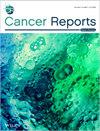Acinic Cell Carcinoma of the Breast: A Population-Based Clinicopathologic Study
Abstract
Purpose
Acinic cell carcinoma (ACC) of the breast is a very rare, primary salivary gland-type breast malignancy, with ~100 reported cases in the literature. Limited information about the clinical features and outcomes of patients with ACC is available.
Methods
We utilized the Surveillance, Epidemiology, and End Results (SEER) database to identify ACC patients. For comparison, we also examined a cohort of invasive breast carcinomas of no special type (NST).
Results
Thirty ACC patients were identified among the more than 248 000 invasive breast carcinoma NST patients. ACCs were predominantly grade 3 carcinomas (44%) and were diagnosed at an earlier stage (67%). Hormone receptor (HR) and HER2 status data were available for only 13 patients, revealing molecular heterogeneity: HR−/HER2− (four patients), HR−/HER2+ (two patients), HR+/HER2− (four patients), and HR+/HER2+ (three patients). The median survival time for ACC patients was 19 months vs. 48 months for NST patients (p < 0.001). A complete-case approach was utilized for the adjusted analyses, restricting the sample to 46 257 patients without missing data on all relevant covariates. The adjusted Kaplan–Meier analysis indicated a more pronounced decline in survival probabilities among patients with ACC compared to those with NST, with the number at risk in the ACC group diminishing to four patients by the 30-month mark. In contrast, NST patients exhibited a more gradual decrease. In the multivariable Cox regression, which adjusted for age, TNM stage, HR/HER2, and chemotherapy, ACC histology was correlated with a 1.69-fold increase in the hazard of death (HR: 1.69; 95% CI: 0.63–4.56), although this result was not statistically significant. Age and advanced stage continued to be strong predictors of poor survival, and the inclusion of an age–time interaction enhanced the model fit.
Conclusion
Acinic cell carcinoma of the breast is a very rare primary breast malignancy. Our study indicates potentially aggressive clinical behavior in mammary ACC; however, findings must be interpreted cautiously given inherent SEER limitations, especially regarding histologic and molecular subtyping accuracy. Further centralized studies are urgently needed for the accurate characterization of this rare entity.


 求助内容:
求助内容: 应助结果提醒方式:
应助结果提醒方式:


